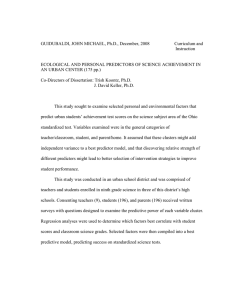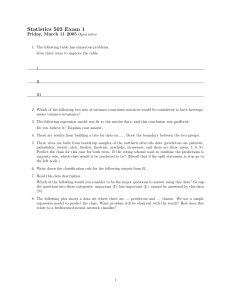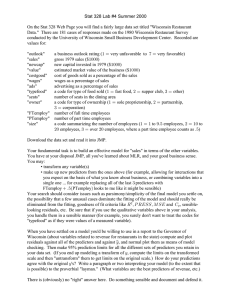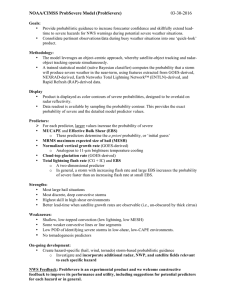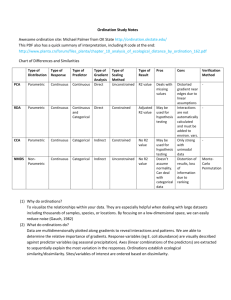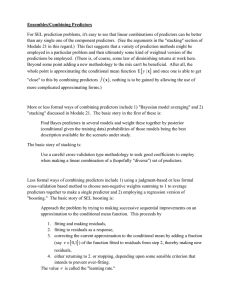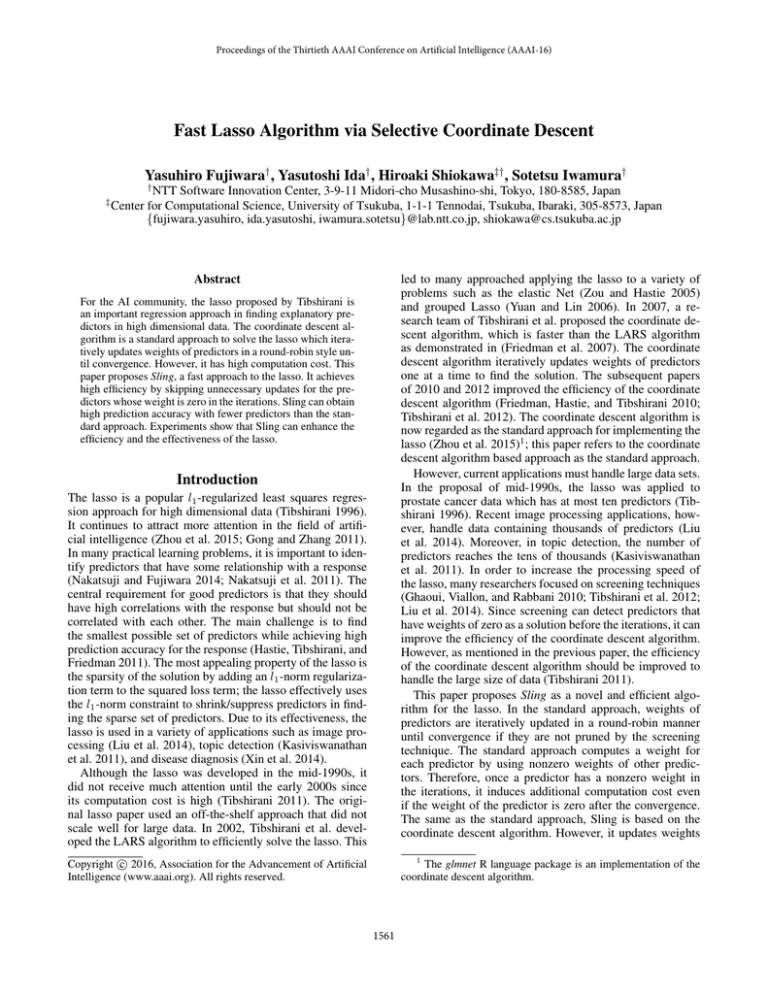
Proceedings of the Thirtieth AAAI Conference on Artificial Intelligence (AAAI-16)
Fast Lasso Algorithm via Selective Coordinate Descent
Yasuhiro Fujiwara† , Yasutoshi Ida† , Hiroaki Shiokawa‡† , Sotetsu Iwamura†
†
‡
NTT Software Innovation Center, 3-9-11 Midori-cho Musashino-shi, Tokyo, 180-8585, Japan
Center for Computational Science, University of Tsukuba, 1-1-1 Tennodai, Tsukuba, Ibaraki, 305-8573, Japan
{fujiwara.yasuhiro, ida.yasutoshi, iwamura.sotetsu}@lab.ntt.co.jp, shiokawa@cs.tsukuba.ac.jp
led to many approached applying the lasso to a variety of
problems such as the elastic Net (Zou and Hastie 2005)
and grouped Lasso (Yuan and Lin 2006). In 2007, a research team of Tibshirani et al. proposed the coordinate descent algorithm, which is faster than the LARS algorithm
as demonstrated in (Friedman et al. 2007). The coordinate
descent algorithm iteratively updates weights of predictors
one at a time to find the solution. The subsequent papers
of 2010 and 2012 improved the efficiency of the coordinate
descent algorithm (Friedman, Hastie, and Tibshirani 2010;
Tibshirani et al. 2012). The coordinate descent algorithm is
now regarded as the standard approach for implementing the
lasso (Zhou et al. 2015)1 ; this paper refers to the coordinate
descent algorithm based approach as the standard approach.
However, current applications must handle large data sets.
In the proposal of mid-1990s, the lasso was applied to
prostate cancer data which has at most ten predictors (Tibshirani 1996). Recent image processing applications, however, handle data containing thousands of predictors (Liu
et al. 2014). Moreover, in topic detection, the number of
predictors reaches the tens of thousands (Kasiviswanathan
et al. 2011). In order to increase the processing speed of
the lasso, many researchers focused on screening techniques
(Ghaoui, Viallon, and Rabbani 2010; Tibshirani et al. 2012;
Liu et al. 2014). Since screening can detect predictors that
have weights of zero as a solution before the iterations, it can
improve the efficiency of the coordinate descent algorithm.
However, as mentioned in the previous paper, the efficiency
of the coordinate descent algorithm should be improved to
handle the large size of data (Tibshirani 2011).
This paper proposes Sling as a novel and efficient algorithm for the lasso. In the standard approach, weights of
predictors are iteratively updated in a round-robin manner
until convergence if they are not pruned by the screening
technique. The standard approach computes a weight for
each predictor by using nonzero weights of other predictors. Therefore, once a predictor has a nonzero weight in
the iterations, it induces additional computation cost even
if the weight of the predictor is zero after the convergence.
The same as the standard approach, Sling is based on the
coordinate descent algorithm. However, it updates weights
Abstract
For the AI community, the lasso proposed by Tibshirani is
an important regression approach in finding explanatory predictors in high dimensional data. The coordinate descent algorithm is a standard approach to solve the lasso which iteratively updates weights of predictors in a round-robin style until convergence. However, it has high computation cost. This
paper proposes Sling, a fast approach to the lasso. It achieves
high efficiency by skipping unnecessary updates for the predictors whose weight is zero in the iterations. Sling can obtain
high prediction accuracy with fewer predictors than the standard approach. Experiments show that Sling can enhance the
efficiency and the effectiveness of the lasso.
Introduction
The lasso is a popular l1 -regularized least squares regression approach for high dimensional data (Tibshirani 1996).
It continues to attract more attention in the field of artificial intelligence (Zhou et al. 2015; Gong and Zhang 2011).
In many practical learning problems, it is important to identify predictors that have some relationship with a response
(Nakatsuji and Fujiwara 2014; Nakatsuji et al. 2011). The
central requirement for good predictors is that they should
have high correlations with the response but should not be
correlated with each other. The main challenge is to find
the smallest possible set of predictors while achieving high
prediction accuracy for the response (Hastie, Tibshirani, and
Friedman 2011). The most appealing property of the lasso is
the sparsity of the solution by adding an l1 -norm regularization term to the squared loss term; the lasso effectively uses
the l1 -norm constraint to shrink/suppress predictors in finding the sparse set of predictors. Due to its effectiveness, the
lasso is used in a variety of applications such as image processing (Liu et al. 2014), topic detection (Kasiviswanathan
et al. 2011), and disease diagnosis (Xin et al. 2014).
Although the lasso was developed in the mid-1990s, it
did not receive much attention until the early 2000s since
its computation cost is high (Tibshirani 2011). The original lasso paper used an off-the-shelf approach that did not
scale well for large data. In 2002, Tibshirani et al. developed the LARS algorithm to efficiently solve the lasso. This
c 2016, Association for the Advancement of Artificial
Copyright Intelligence (www.aaai.org). All rights reserved.
1
The glmnet R language package is an implementation of the
coordinate descent algorithm.
1561
in a selective style unlike the standard approach; it updates
only the predictors that must have nonzero weights in the
iterations. After convergence, our approach updates the predictors that are expected to have nonzero weights. Since we
avoid updating the predictors whose weights are zero in the
iterations, our approach can efficiently obtain the solution
for the lasso. Note that the screening technique prunes predictor whose weights are zero before entering the iterations
while our approach prunes predictors in the iterations. If p is
the number of predictors where each predictor has n observations, the given data is represented as a n×p matrix. When
the matrix has full column rank, our approach provably guarantees to output the same result as the standard approach.
Moreover, our approach achieves high prediction accuracy
by using fewer predictors than the standard approach. Experiments demonstrate that Sling cuts the processing time
by up to 70% from the standard approach. To the best of our
knowledge, this is the first study to improve the efficiency of
the standard approach for the lasso by pruning unnecessary
predictors in the iterations.
Banerjee 2014). However, as described in (Li et al. 2015;
Zhou et al. 2015), the ADMM-based approach does not effectively reduce the computation time for the lasso relative
to glmnet which is based on the coordinate descent algorithm; the coordinate descent algorithm is more efficient
than ADMM for the lasso as demonstrated in (Li et al. 2014).
Preliminary
This section introduces the standard approach for the lasso.
In the regression scenario, we are provided with a response
vector and p predictor vectors of n observations. We assume each vector is centered and normalized. Let y =
(y[1], y[2], . . . , y[n]) be the response vector where y ∈
Rn . In addition, let X ∈ Rn×p be the matrix of p predictors
where xi is the i-th column vector in matrix X. Note that xi
corresponds to each predictor. The lasso learns the following
sparse linear model to predict y from X by minimizing the
squared loss and an l1 -norm constraint (Tibshirani 1996):
1
y − Xw22 + λw1
(1)
minw∈Rp 2n
where w = (w[1], w[2], . . . , w[p]) denotes the weight vector and λ > 0 is a tuning parameter; weight w[i] corresponds
to the i-th predictor pi . If matrix X has full column rank, we
have a unique solution for the optimization problem (Hastie,
Tibshirani, and Friedman 2011). Otherwise, which is necessarily the case when p > n, there may not be a unique
solution. The optimal λ is usually unknown in practical applications. Therefore, we need to solve Equation (1) for a
series of tuning parameters λ1 > λ2 > . . . > λK where
K is the number of tuning parameters, and then select the
solution that is optimal in terms of a pre-specified criterion
such as the Schwarz Bayesian information criterion, Akaike
information criterion or cross-validation (Bishop 2007).
Tibshirani et al. proposed a coordinate descent algorithm
that updates predictor weights one at a time (Friedman et al.
2007). The coordinate descent algorithm partially conducts
the optimization with respect to weight w[i] by supposing
that it has already estimated other weights. It computes the
gradient at w[i] = w̃[i], which only exists if w[i] = 0. If
w̃[i] > 0, we have the following equation for the gradient by
differentiating Equation (1) with respect to w[i]:
p
n − n1 j=1 x[j, i](y[j] − k=1 x[j, k]w̃[k]) + λ (2)
Related Work
Since the lasso is an important regression approach used in
a variety of applications such as image processing, topic detection, and disease diagnosis, many approaches have been
developed to efficiently solve it.
By employing the sparsity in the solutions of the
lasso, several screening techniques prune predictors whose
weights are zero before entering the iterations (Liu et al.
2014; Tibshirani et al. 2012; Ghaoui, Viallon, and Rabbani
2010). Since recent applications must handle large numbers of predictors, screening techniques have been attracting much interest. However, these techniques do not enhance
prediction accuracy unlike our approach. Since our approach
is based on the standard approach, it adopts the sequential
strong rule. However, our approach can also use previous
other screening techniques.
To efficiently solve the lasso, several approaches transform l1 -regularized least squares as a constrained quadratic
programming problem such as the interior method (Kim
et al. 2007), GPSR (Figueiredo, Nowak, and Wrigh 2007),
and ProjectionL1 (Schmidt, Fung, and Rosales 2007). However, these approaches double variable size, raising computational cost. DPNM proposed by Gong et al. derives another dual form of l1 -regularized least squares to apply a
projected Newton method to efficiently solve the dual problem (Gong and Zhang 2011). However, their approach has
a limitation in that it assumes n ≥ p and matrix X must
have full column rank. Zhou et al. proposed an interesting
approach that transforms the lasso regression problem into
a binary SVM classification problem to allow efficient solution computation (Zhou et al. 2015). However, their approach does not guarantee to output the optimal solution
for the lasso. FISTA is a scalable proximal method for l1 regularized optimization which can be applied to various
loss functions (Beck and Teboulle 2009). However, its convergence rate tends to suffer if predictors have high correlation. ADMM is another popular approach for l1 -regularized
optimization problems such as the lasso (Das, Johnson, and
where w̃ = (w̃[1], w̃[2], . . . , w̃[p]) is a weight vector and
x[j, i] is (j, i)-th element of matrix X. A similar expression
exists if w̃[i] < 0, and w̃[i] = 0 is treated separately. The
coordinate descent algorithm updates weights as follows:
z[i]−λ (z[i] > 0 and |z[i]| > λ)
w̃[i] ← S(z[i], λ) = z[i]+λ (z[i] < 0 and |z[i]| > λ) (3)
0
(|z[i]| ≤ λ)
In Equation (3), S(z[i], λ) is the soft-thresholding operator
(Friedman et al. 2007) and z[i] is a parameter for the i-th
predictor given as follows:
n
(4)
z[i] = n1 j=1 x[j, i](y[j] − ỹ (i) [j])
where ỹ (i) [j] = k=i x[j, k]w̃[k]. The coordinate descent
algorithm iteratively updates weights in a round-robin manner; we iteratively update all predictors by using Equation (3) until convergence.
1562
Tibshirani et al. proposed an efficient way to compute parameter z[i] used in the updates (Friedman, Hastie, and Tibshirani 2010). They transformed Equation (4) as follows:
(5)
z[i] = w̃[i] + n1 xi , y − j:|w̃[j]|>0 xi , xj w̃[j]
the efficiency of the standard approach since we effectively
prune the unnecessary predictors in the iteration (Shiokawa,
Fujiwara, and Onizuka 2015; Fujiwara and Irie 2014). If matrix X has full column rank, our approach outputs the same
result as the standard approach since there is a unique lasso
solution due to its convex property (Tseng 2001). Otherwise, our approach can more accurately predict the response
with fewer predictors than the standard approach since it can
avoid updating predictors that give zero gradient by using
the bounds in the iterations.
where xi ,
y is the inner product of vector xi and y, i.e.,
n
xi , y = j=1 x[j, i]y[j]. Note that Equation (4) and (5)
give the same result. If m is the number of predictors that
have nonzero weights, Equation (5) requires O(m) time to
update a weight while Equation (4) needs O(n) time. Since
the lasso sparsely selects predictors, we have m n. Therefore, we can update weights more efficiently by using Equation (5) instead of Equation (4). To exploit Equation (5), we
need to initially compute the inner products of response vector y with each predictor vector xi before the iterations. In
addition, each time a predictor vector xj is adopted by the
model to predict the response vector, we need to compute its
inner product with all remaining predictors. That is, if a predictor is additionally determined to have a nonzero weight
in the solution, the inner products of the predictor with other
predictors must be computed to use Equation (5).
So as to increase the efficiency, several researchers, including Tibshirani et al., proposed screening techniques to
detect predictors whose weights are zero (Ghaoui, Viallon,
and Rabbani 2010; Tibshirani et al. 2012; Liu et al. 2014).
Let w̃λk be the solution for tuning parameter λk , Tibshirani
et al. proposed the sequential strong rule that discards the
i-th predictor for tuning parameter λk if we have
1
n |xi (y
− Xw̃λk−1 )| < 2λk − λk−1
Upper and Lower Bounds
In each iteration, we compute the upper/lower bounds of parameter z[i] for each predictor by setting a reference vector; the reference vector consists of weights of predictors
set prior to commencing the iterations. In order to compute the bounds, we apply the Cauchy-Schwarz inequality (Steele 2004) to determine the difference between the
reference vector and a weight vector in the iterations. Let
w̃r = (w̃r [1], w̃r [2], . . . , w̃r [p]) be the reference vector,
we define the upper bound of parameter z[i] as follows:
Definition 1 Let z[i] be the upper bound of parameter z[i],
z[i] is given as follows:
z[i] = w̃[i] − w̃r [i] + n1 vi 2 w̃ − w̃r 2 + zr [i]
(7)
In Equation (7), vi is a vector of length p whose j-th element is xi , xj , the inner product of vector xi and xj . In
addition, zr [i] is a score of parameter z[i] given by reference
vector w̃r , i.e., zr [i] is computed as follows:
zr [i] = w̃r [i]+ n1 xi , y− j:|w̃r [j]|>0 xi , xj w̃r [j] (8)
(6)
Since their screening technique may erroneously discard
predictors that have nonzero weights, all discarded predictors are checked by the Karush-Kuhn-Tucker (KKT) condition after convergence. The KKT condition is that n1 |x
i (y−
Xw̃λj )| ≤ λ holds if w̃i = 0. However, the efficiency of the
coordinate descent algorithm must be improved to handle
the large data sizes as described in (Tibshirani 2011).
Note that we can compute vi 2 and zr [i] in Equation (7)
before commencing the iterations since they have constant
scores throughout the iterations. On the other hand, we need
O(p) time to compute w̃ − w̃r 2 in each iteration since
w is a vector of length p that is updated in each iteration.
Similarly, the lower bound is defined as follows:
Definition 2 If z[i] is the lower bound of parameter z[i], z[i]
is given by the following equation:
Proposed Approach
z[i] = w̃[i] − w̃r [i] − n1 vi 2 w̃ − w̃r 2 + zr [i]
We present our proposal, Sling, that efficiently computes the
solution for the lasso based on the standard approach. First,
we overview the ideas underlying Sling. That is followed by
a full description. Note that our approach can be applied to
the variants of the lasso such as the elastic Net and grouped
Lasso although we focus on the lasso in this paper.
(9)
We show the following two lemmas to show that z[i] and
z[i] give the upper and lower bounds, respectively;
Lemma 1 For parameter z[i] of the i-th predictor pi , we
have z[i] ≥ z[i] in the iterations.
Proof Since vi is a vector whose j-th element is xi , xj ,
from Equation (5) and (8), we have
Ideas
As described in the previous section, the standard approach
iteratively updates weights of all predictors by computing
parameter z[i] in a round-robin style. In order to increase
efficiency, we do not update the weights of all predictors.
Instead, our approach skips unnecessary updates; it first updates only predictors that must have nonzero weights until
convergence. It then updates the predictors that are likely
to have nonzero weights. Our approach dynamically determines the updated predictors by computing lower and upper
bounds of parameter z[i] in each iteration. We can improve
z[i] = w̃[i]+ n1 (xi , y−vi , w̃)
= w̃r [i]+ w̃[i]− w̃r [i]+ n1 (xi , y−vi , w̃r −vi , w̃− w̃r )
= zr [i] + w̃[i]− w̃r [i]− n1 vi , w̃− w̃r From the Cauchy-Schwarz inequality, we have
− n1 vi , w̃ − w̃r ≤
1
n vi 2 w̃
− w̃r 2
As a result, we have
z[i] ≤ w̃[i]− w̃r [i]+ n1 vi 2 w̃− w̃r 2 +zr [i] = z[i]
1563
Lemma 2 In the iterations, z[i] ≤ z[i] holds for parameter
z[i] of the i-th predictor, pi .
Algorithm 1 Sling
1: for k = 1 to K do
2:
λ := λk ;
3:
if k = 1 then
4:
U := ∅;
5:
else
6:
U := Pk−1 ;
7:
compute initial weights by Equation (11);
8:
repeat
9:
repeat
10:
w̃r := w̃;
11:
for each pi ∈ U do
12:
compute z̃r [i] from w̃r ;
13:
repeat
14:
for each pi ∈ U do
15:
if z[i] > λ or z[i] < −λ then
16:
update w̃[i] by Equation (5);
17:
update w̃ − w̃r 2 by Equation (10);
18:
until w̃ reaches the convergence
19:
w̃r := w̃;
20:
for each pi ∈ U do
21:
compute z̃r [i] from w̃r ;
22:
repeat
23:
for each pi ∈ U do
24:
if z[i] > λ or z[i] < −λ then
25:
update w̃[i] by Equation (5);
26:
else
27:
w̃[i] = 0;
28:
update w̃ − w̃r 2 by Equation (10);
29:
until w̃ reaches the convergence
30:
for each pi ∈ Sk do
31:
if pi violates the KKT condition then
32:
add pi to U ;
33:
until ∀pi ∈ Sk , pi does not violate KKT condition
34:
for each pi ∈ P do
35:
if pi violates the KKT condition then
36:
add pi to U ;
37:
until ∀pi ∈ P, pi does not violate KKT condition
We omit proof of Lemma 2 because of space limitations.
However, it can be proved in a similar fashion to Lemma 1
by using the Cauchy-Schwarz inequality.
In terms of computation cost, O(p) time is needed to compute the bounds if we naively use Equation (7) and (9) since
it needs O(p) time to compute w̃− w̃r 2 . However, we can
efficiently update w̃ − w̃r 2 . If w̃ [i] is the score of w̃[i]
before the update and w̃ is the vector of weights before the
update, we can update w̃ − w̃r 2 as follows:
w̃ − w̃r 2 = w̃ − w̃r 22 − (w̃ [i])2 + (w̃[i])2 (10)
Clearly O(1) time is needed to update w̃−w̃r 2 every time
a weight is updated from Equation (10). Thus, we have the
following property in computing the upper/lower bounds:
Lemma 3 For each predictor, it requires O(1) time to compute the upper/lower bounds in each iteration.
Proof If a weight is updated, we can obtain w̃ − w̃r 2
at O(1) time. In addition, it requires O(1) time to obtain
w̃[i] − w̃r [i], vi 2 , and zr [i] in the iterations; we can precompute vi 2 and zr [i] before commencing the iterations.
Therefore, it is clear that we can compute the upper/lower
bounds at O(1) time from Equation (7) and (9).
Predictors of Nonzero Weights
We identify the predictors that must/can have nonzero
weights by computing the bounds. We can improve the efficiency of the lasso since we can effectively avoid updating
the unnecessary predictors (Fujiwara and Shasha 2015). Our
approach is based on the properties for predictors that have
nonzero weights. The first property is given as follows for
predictors that must have nonzero weights in the iterations:
Proof It is clear from Lemma 5.
Note that if a predictor meets the condition of Lemma 4,
the predictor must meet the condition of Lemma 6; a set of
predictors of Lemma 4 is included in a set of predictors of
Lemma 6. This is because we have (1) z[i] > λ if z[i] > λ
and (2) z[i] < −λ if z[i] < −λ. Therefore, if a predictor must have a nonzero weight by Lemma 4, the predictor can have a nonzero weight by Lemma 6. In addition, if
a predictor does not meet the condition of Lemma 6, the
weight of the predictor must be zero from Lemma 5. We
employ Lemma 4 and 6 to effectively update predictors that
must/can have nonzero weights in the iterations.
Lemma 4 Predictor pi must have a nonzero weight if z[i] >
λ or z[i] < −λ holds for parameter z[i].
Proof In the case of z > λ, we have z[i] ≥ z[i] > λ > 0
and |z[i]| ≥ |z[i]| > λ since λ > 0 and z[i] ≥ z[i] from
Lemma 2. As a result, we have w[i] = z[i] − λ from Equation (3) if z > λ holds for predictor pi . If z[i] < −λ holds,
we similarly have z[i] < 0 and |z[i]| > λ. Therefore, the
score of weight w̃[i] must be nonzero from Equation (3). In order to introduce the property of predictors that may
have nonzero weights, we show the following property of
predictors whose weights must be zero in the iterations:
Algorithm
Algorithm 1 gives a full description of Sling. It is based on
the standard approach of the lasso, where the weights of
predictors are updated by the transformed equation (Equation (5)) and unnecessary predictors are pruned by the sequential strong rule as described in the previous section. Our
approach computes the solutions of the lasso for a series of
tuning parameters λ1 > λ2 > . . . > λK . In Algorithm 1, U
is a set of predictors updated in the iterations, P is a set of
all p predictors, Pk is a set of predictors that have nonzero
weights as the solution for tuning parameter λk , and Sk are
predictors that survive the sequential strong rule for λk . For
λk , we compute initial scores of the weights based on the
observation that the solution for λk is similar to the solution
Lemma 5 If we have z[i] ≤ λ and z[i] ≥ −λ for parameter
z[i], the weight of predictor pi must be zero in the iterations.
Proof If z[i] ≤ λ and z[i] ≥ −λ hold, we have −λ ≤ z[i] ≤
z[i] ≤ z[i] ≤ λ for parameter z[i]. Therefore, |z[i]| ≤ λ
holds for parameter z[i]. As a result, we have w̃[i] = 0 from
Equation (3) if z[i] ≤ λ and z[i] ≥ −λ hold.
From Lemma 5, we have the following lemma for predictors that may have nonzero weights:
Lemma 6 Predictor pi can have a nonzero weight if z[i] >
λ or z[i] < −λ for parameter z[i].
1564
for λk−1 . Specifically, if wλk [i] is the weight of predictor
pi in the solution for parameter λk , we compute the initial
scores of the weight for parameter λk as follows:
0
(k = 1)
(k = 2)
wλk−1 [i]
w̃[i] =
(11)
wλk−1 [i] + Δwλk−1 [i] (k ≥ 3)
In Theorem 1, we assume that mk = 0 if k = 0. Since
our approach can effectively prune predictors by using upper/lower bounds (Fujiwara et al. 2013), it can improve the
efficiency of the standard approach for implementing the
lasso. In terms of the regression results, our approach has
the following property for a given tuning parameter:
where Δwλk−1 [i] = wλk−1 [i] − wλk−2 [i].
In Algorithm 1, our approach first sets λ := λk and then
initializes U := ∅ if k = 1 and U := Pk−1 otherwise similar to the standard approach (Tibshirani et al. 2012) (lines
2-6). It then computes the initial scores of weights by using Equation (11) (line 7). Before iteratively updating the
weights of the predictors, it sets the reference vector and
computes parameter z[i] for the vector in order to compute the upper/lower bounds (lines 10-12 and 19-21). In
each iterative update, our approach first selects predictors
that must have nonzero weights by using the condition of
Lemma 4 (lines 13-18). It then performs the iterative update
by employing Lemma 6 to identify predictors that may have
nonzero weights (lines 22-29). After convergence, our approach checks the KKT condition for predictors pi such that
pi ∈ Sk (lines 30-32) and pi ∈ P (lines 34-36) in order to
verify that no predictor violates the KKT condition (line 33
and 37). This process is the same as the standard approach
(Tibshirani et al. 2012).
After we obtain the solutions for each tuning parameter,
we can select the solution that is optimal in terms of a prespecified criterion such as Schwarz Bayesian information
criterion. In terms of the computation cost, our approach has
the following property:
Theorem 1 If mk is the number of predictors that have
nonzero weights in the iterations for tuning parameter λk
and t is the number of update computations, our approach
requires O(mk t+np max{0, mk −mk−1 }) time to compute
the solution for λk .
Proof As shown in Algorithm 1, our approach first initializes the set of predictor U and computes the initial scores
of weights from Equation (11). These processes need O(p)
time. It then sets the reference vector in O(mk ) time. In the
iterations, it updates weights in O(mk t) time. This is because we can compute the updated weights as well as the
KKT condition and parameter z[i] for the reference vector by using Equation (5) which requires O(mt ) time for
each computation. Note that our approach can compute the
upper/lower bounds in each iteration in O(t) time since
it needs O(1) to compute the bounds in each iteration as
shown in Lemma 3. In addition, as described in the previous section, if a predictor is additionally determined to have
a nonzero weight in the solution, we need to compute its
inner product with all the other predictors when using Equation (5). Since (1) we need O(np) time to compute inner
products of each predictor for other predictors where n is the
number of observations and (2) the number of predictors is
max{0, mk −mk−1 } to additionally compute the inner products, it requires O(np max{0, mk −mk−1 }) time to compute
the inner product when utilizing Equation (5). As a result,
our approach needs O(mk t+np max{0, mk −mk−1 }) time
for given parameter λk .
Theorem 2 Our approach converges the same solution as
the standard approach if matrix X has full column rank.
Proof As shown in Algorithm 1, our approach first updates predictors if we have z[i] > λ or z[i] < −λ for each
predictor. It then updates predictors such that z[i] > λ or
z[i] < −λ. Note that it is clear that we have z[i] > λ or
z[i] < −λ if z[i] > λ or z[i] < −λ hold. As a result, these
two processes indicate that our approach does not update
predictors if z[i] ≤ λ and z[i] ≥ −λ hold for each parameter. For a predictor whose z[i] ≤ λ and z[i] ≥ −λ, its weight
must be zero as shown in Lemma 5. As a result, our approach cannot prune a predictor if it has a nonzero weight in
any iteration. Since there is a unique lasso solution if matrix
X has full column rank, the coordinate descent algorithm
will converge to the unique solution (Tibshirani et al. 2012;
Friedman, Hastie, and Tibshirani 2010). Since our approach
and the standard approach are based on coordinate descent,
it is clear that our approach converges the same results as the
standard approach if matrix X has full column rank.
If matrix X does not have full column rank, which is necessarily the case when p > n, there may not be a unique
lasso solution. In that case, our approach can yield high accuracy while using fewer predictors than the standard approach. In the next section, we detail experiments that show
the efficiency and effectiveness of Sling.
Experimental Evaluation
We performed experiments on the datasets of DNA, Protein,
Reuters, TDT2, and Newsgroups to show the efficiency and
effectiveness of our approach. The datasets have 600, 2871,
8293, 10212, and 18846 items, respectively. In addition, they
have 180, 357, 18933, 36771, and 26214 features, respectively. Details of the datasets are shown in Chih-Jen Lin’s
webpage2 and Deng Cai’s webpage3 . In the experiments, we
randomly picked one feature as the response vector y, and
then set the remaining features as the matrix of predictors X
the same as the previous paper (Liu et al. 2014). Note that
the number of data items corresponds to the number of observations, n. Since we have p > n in Reuters, TDT2, and
Newsgroups, matrix X does not have full column rank while
matrix X is full column rank for DNA and Protein.
We set λ1 = n1 maxi |xi , y| and λK = 0.001λ1 by following the previous paper (Friedman, Hastie, and Tibshirani
2010). We constructed a sequence of K scores of tuning parameters decreasing from λ1 to λK on a log scale where
K = 50. In this section, “Sling” and “Standard” represent
the results of our approach and the standard approach, respectively. The standard approach prunes predictors by the
2
3
1565
http://www.csie.ntu.edu.tw/ cjlin/libsvmtools/datasets/multiclass.html
http://www.cad.zju.edu.cn/home/dengcai/Data/TextData.html
1
100
10-1
10-2
10
-3
10
-4
DNA
Protein
Reuters
TDT2 Newsgroups
10
4
10
3
10
2
10
1
10
0
Figure 1: Processing time of
each approach.
104
Sling
Standard
10
Protein
Reuters
3
102
10
DNA
1
TDT2 Newsgroups
Figure 2: Number of update
computations in the iterations.
DNA
Protein
Reuters
TDT2
Newsgroups
Squared loss
Sling
Standard
5.097×10−2
2.616×10−3
5.003×10−6
1.679×10−6
3.463×10−6
5.097×10−2
2.616×10−3
5.006×10−6
1.691×10−6
3.478×10−6
Protein
Reuters
Sling
Standard
103
102
10
TDT2 Newsgroups
4
1
DNA
Protein
Reuters
TDT2 Newsgroups
Figure 4: Number of nonzero
weight predictors.
Effectiveness
In this section, we evaluate the prediction error for the given
responses of each approach. This experiment performed
leave-one-out cross validation in evaluating the prediction
error in terms of the squared loss for the response. Table 1
shows the prediction error and scores of the objective function (Equation (1)). In addition, we show the average number
of nonzero weight predictors in Figure 4.
As expected, experimental results indicate that the prediction error and the number of nonzero weight predictors of
our approach are the same as those of the standard approach
if matrix X has full column rank (DNA and Protein). This is
because our approach is guaranteed to yield the same solution as the standard approach as described in Theorem 2. In
addition, for p > n (Reuters, TDT2, and Newsgroups), our
approach uses fewer predictors than the standard approach
while slightly improving the prediction error compared to
the standard approach. As shown in Algorithm 1, we update
predictors that must/can have nonzero weights by computing
the upper/lower bounds of parameter z[i]. Therefore, if |z[i]|
has a large score, our approach is likely to update predictor
pi that corresponds to z[i]. Since parameter z[i] is introduced
from the gradient at w[i] = w̃[i] as shown in Equation (2),
our approach can effectively identify predictors of high gradients in each iteration. As a result, our approach can effectively compute the solution for the optimization problem
of Equation (1) by using the upper/lower bounds. Therefore,
scores of the objective function of our approach are less than
those of the standard approach as shown in Table 1. On the
other hand, since the standard approach updates predictors in
round-robin style, it can update ineffective predictors as the
solution whose weight are zero after convergence. Table 1,
along with Figure 1, indicates that our approach improves
the efficiency while its prediction results match the accuracy
of the standard approach. Thus, Sling is an attractive option
for the research community in performing the lasso.
Object function
Sling
Standard
5.866×10−2
4.492×10−3
7.241×10−6
2.760×10−6
4.811×10−6
DNA
Figure 3: Number of predictors whose inner products are
computed.
Table 1: Prediction results of each approach
Dataset
10
Sling
Standard
#update computations
Wall clock time [s]
10
Sling
Standard
#predictors of inner product computations
3
102
#update computations
10
5.866×10−2
4.492×10−3
7.251×10−6
2.795×10−6
4.838×10−6
sequence strong rule and updates the weights by transforming the equation. Since we evaluated each approach by setting a series of tuning parameters λ, we report average values of the experimental results. We conducted all experiments on a Linux 2.70 GHz Intel Xeon server. We implemented all approaches using GCC.
Efficiency
Figure 1 shows the processing time of each approach. In addition, Figure 2 shows the number of updates and Figure 3
shows the number of predictors whose inner products were
computed in the iterations.
Figure 1 indicates that our approach greatly improves the
efficiency of the standard approach; it cuts the processing
time by up to 70% from the standard approach. As described in the previous sections, the standard approach updates all the predictors that survive the sequential screening rule. On the other hand, our approach effectively avoids
updating all the survived predictors by computing the upper/lower bounds although our approach employs the sequential screening rule the same as the standard approach.
Therefore, the number of update computation of our approach is fewer than that of the standard approach as shown
in Figure 2. In addition, as shown in Figure 3, Sling can effectively reduce the number of inner product computations,
especially if p > n (Reuters, TDT2, and Newsgroups). This
is because Sling reduces the number of predictors used if
matrix X does not have full column rank as we will discuss
later. Since our approach effectively reduces the number of
updates and inner product computations, it offers superior
efficiency over the standard approach.
Conclusions
The lasso is an important l1 -regularized least squares regression approach for high dimensional data in the AI community. We proposed Sling, an efficient algorithm that improves the efficiency of applying the lasso. Our approach
avoids updating predictors whose weights must/can be zero
in each iteration. Experiments showed that our approach offers improved efficiency and effectiveness over the standard
1566
approach. The lasso is a fundamental approach used in variety of applications such as image processing, topic detection, and disease diagnosis. Our approach will allow many
lasso-based applications to be processed more efficiently,
and should improve the effectiveness of future applications.
cision Matrix Estimation in R. Journal of Machine Learning
Research 16:553–557.
Liu, J.; Zhao, Z.; Wang, J.; and Ye, J. 2014. Safe Screening
with Variational Inequalities and Its Application to Lasso. In
ICML, 289–297.
Nakatsuji, M., and Fujiwara, Y. 2014. Linked Taxonomies to
Capture Users’ Subjective Assessments of Items to Facilitate
Accurate Collaborative Filtering. Artif. Intell. 207:52–68.
Nakatsuji, M.; Fujiwara, Y.; Uchiyama, T.; and Fujimura, K.
2011. User Similarity from Linked Taxonomies: Subjective
Assessments of Items. In IJCAI, 2305–2311.
Schmidt, M. W.; Fung, G.; and Rosales, R. 2007. Fast Optimization Methods for L1 Regularization: A Comparative
Study and Two New Approaches. In ECML, 286–297.
Shiokawa, H.; Fujiwara, Y.; and Onizuka, M. 2015.
SCAN++: Efficient Algorithm for Finding Clusters, Hubs
and Outliers on Large-scale Graphs. PVLDB 8(11):1178–
1189.
Steele, J. M. 2004. The Cauchy-Schwarz Master Class: An
Introduction to the Art of Mathematical Inequalities. Cambridge University Press.
Tibshirani, R.; Bien, J.; Friedman, J.; Hastie, T.; Simon, N.;
Taylor, J.; and Tibshirani, R. J. 2012. Strong Rules for Discarding Predictors in Lasso-type Problems. Journal of the
Royal Statistical Society: Series B (Statistical Methodology)
74(2):245–266.
Tibshirani, R. 1996. Regression Shrinkage and Selection via
the Lasso. Journal of the Royal Statistical Society, Series B
58:267–288.
Tibshirani, R. 2011. Regression Shrinkage and Selection via
the Lasso: a Retrospective. Journal of the Royal Statistical
Society: Series B 73(3):273–282.
Tseng, P. 2001. Convergence of a Block Coordinate Descent Method for Nondifferentiable Minimization. Journal
of Optimization Theory and Applications 109(3):475–494.
Xin, B.; Kawahara, Y.; Wang, Y.; and Gao, W. 2014. Efficient Generalized Fused Lasso and Its Application to the
Diagnosis of Alzheimer’s Disease. In AAAI, 2163–2169.
Yuan, M., and Lin, Y. 2006. Model Selection and Estimation
in Rregression with Grouped Variables. Journal of the Royal
Statistical Society: Series B 68(1):49–67.
Zhou, Q.; Chen, W.; Song, S.; Gardner, J. R.; Weinberger,
K. Q.; and Chen, Y. 2015. A Reduction of the Elastic Net to
Support Vector Machines with an Application to GPU Computing. In AAAI, 3210–3216.
Zou, H., and Hastie, T. 2005. Regularization and Variable
Selection via the Elastic Net. Journal of the Royal Statistical
Society: Series B 67(2):301–320.
References
Beck, A., and Teboulle, M. 2009. A Fast Iterative Shrinkagethresholding Algorithm for Linear Inverse Problems. SIAM
J. Imaging Sciences 2(1):183–202.
Bishop, C. M. 2007. Pattern Recognition and Machine
Learning. Springer.
Das, P.; Johnson, N.; and Banerjee, A. 2014. Online Portfolio Selection with Group Sparsity. In AAAI, 1185–1191.
Figueiredo, M. A. T.; Nowak, R. D.; and Wrigh, S. J. 2007.
Gradient Projection for Sparse Reconstruction: Application
to Compressed Sensing and Other Inverse Problems. IEEE
Journal on Selected Topics in Signal Processing 1(4):586 –
597.
Friedman, J.; Hastie, T.; Höfling, H.; and Tibshirani, R.
2007. Pathwise Coordinate Optimization. Annals of Applied
Statistics 1(2):302–332.
Friedman, J. H.; Hastie, T.; and Tibshirani, R. 2010. Regularization Paths for Generalized Linear Models via Coordinate Descent. Journal of Statistical Software 33(1):1–22.
Fujiwara, Y., and Irie, G. 2014. Efficient Label Propagation.
In ICML, 784–792.
Fujiwara, Y., and Shasha, D. 2015. Quiet: Faster Belief
Propagation for Images and Related Applications. In IJCAI,
3497–3503.
Fujiwara, Y.; Nakatsuji, M.; Shiokawa, H.; Mishima, T.; and
Onizuka, M. 2013. Fast and Exact Top-k Algorithm for
PageRank. In AAAI.
Ghaoui, L. E.; Viallon, V.; and Rabbani, T. 2010. Safe
Feature Elimination in Sparse Supervised Learning. CoRR
abs/1009.3515.
Gong, P., and Zhang, C. 2011. A Fast Dual Projected
Newton Method for l1 -regularized Least Squares. In IJCAI,
1275–1280.
Hastie, T.; Tibshirani, R.; and Friedman, J. 2011. The Elements of Statistical Learning. Springer.
Kasiviswanathan, S. P.; Melville, P.; Banerjee, A.; and Sindhwani, V. 2011. Emerging Topic Detection Using Dictionary
Learning. In CIKM, 745–754.
Kim, S.-J.; Koh, K.; Lustig, M.; Boyd, S.; and Gorinevsky,
D. 2007. An Interior-Point Method for Large-Scale L1Regularized Least Squares. IEEE Journal of Selected Topics
in Signal Processing 1(4):606–617.
Li, X.; Zhao, T.; Yuan, X.; and Liu, H. 2014. An
R Package flare for High Dimensional Linear Regression and Precision Matrix Estimation.
https://cran.rproject.org/web/packages/flare/vignettes/vignette.pdf.
Li, X.; Zhao, T.; Yuan, X.; and Liu, H. 2015. The flare
Package for High Dimensional Linear Regression and Pre-
1567

